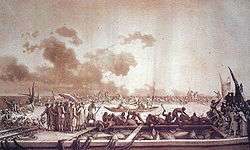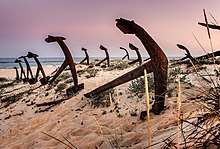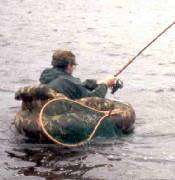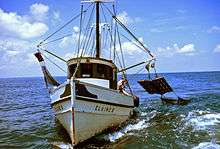Almadraba
Almadraba in Spanish (Italian: Mattanza and Portuguese: Almadrava) is a word of Al-Andalus Arabic origin المضربة almaḍraba : 'a place to strike' < Arabic root ضرب 'to strike, hit'. It is an elaborate and age-old Phoenician technique for trapping and catching Atlantic bluefin tuna that was learned and taken to areas such as Iberia during Iberia's Islamic period.[1]

etching by Jean-Pierre Houël, 1782.
The technique is to trap and catch the tuna when they are crossing between the Atlantic Ocean to the Mediterranean during February to July, on their way to spawn and until recently, on its return journey, ("al revés") when they come back into the Atlantic Ocean,; the bycatch contains, among others, bullet tuna (Auxis rochei), little tunny (Euthynnus alletteratus), Atlantic bonito (Sarda sarda), bigeye tuna (Thunnus obesus) and swordfish (Xiphias gladius).
It is a traditional form of tuna fishing or netting fence to catch tuna that is carried out in Italy (Mainly in Sicily and Sardinia), Morocco, Portugal (Mainly in the Algarve) and Spain (Mainly Andalusia, Murcia and Valencia).[2][3]
A similar technique exists in Sicily known as mattanza (a borrowing from the Spanish word matanza, meaning slaughter), introduced either by the Moors during Sicily's own Islamic period or by the Spanish afterwards.
In film
- Roberto Rossellini's Stromboli includes documentary shots of the mattanza.
- Rupert Murray's The End of the Line (2009 film) demonstrates almadraba when discussing declining catches.
- Portuguese short documentary film pt:A Almadraba Atuneira, directed by Antonio Campos.
See also

- Barbate, town known for its Almadraba fishing.
- Favignana, a Sicilian island where mattanza is performed.
- The Dukes of Medina-Sidonia made their fortune on the monopoly of Andalusian almadrabas from the 12th to the 19th century.
- Zahara de los Atunes, an Andalusian town named after the tunas of its almadraba.
- Castle of Zahara de los Atunes and Palace of Jadraza
- Tavira Island, in the Algarve, Portugal.
References
- "Las almadrabes y Chiclana". Archived from the original on 27 June 2010.
- almadraba Diccionario de la lengua española, Vigésima segunda edición, Real Academia Española, 2001. (in Spanish)
- "THE FUTURE OF THE ALMADRABA SECTOR – TRADITIONAL TUNA FISHING METHODS IN THE EU - PDF" (PDF). Retrieved 30 May 2017.


